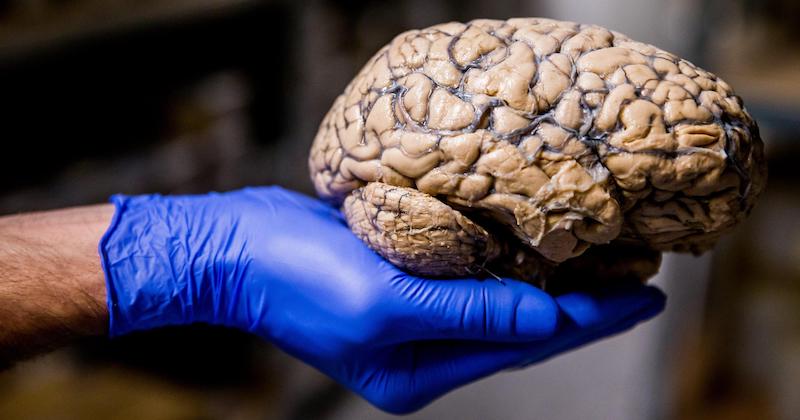Loading player
In a basement of the University of Southern Denmark in Odense, the country’s third largest city, nearly 10,000 human brains are collected in what is believed to be the largest collection of this kind in the world. Today some of these brains are used in scientific research, but in Denmark there has been a long debate about their use: they had belonged to people admitted to Danish psychiatric hospitals between the 1940s and 1980s, and had been removed without them or family members had given no consent. For decades in Denmark, news about the collection was scarce and little commented: in the 1990s, however, its existence was at the center of one of the main ethical debates in the history of the country.
The idea of preserving the brains extracted from patients who died in the psychiatric hospitals of the country came from the Danish doctor Erik Strömgren and the Icelandic researcher Lárus Einarson, who in 1945 founded the institute of brain pathology at the Risskov psychiatric hospital in Aarhus, the second largest city in Denmark. At that time, doing autopsies on the bodies of dead people was the norm. As Jesper Vaczy Kragh, an expert on the history of psychiatry, explained, conserving brains instead was part of a type of experimental research: the idea was that doctors «perhaps could understand where mental illnesses were located, or find some answers», as doctors and psychiatrists had been doing for some decades in other countries, including Italy.
The Aarhus institute began receiving, cataloging and storing brains sent by post from various psychiatric hospitals throughout Denmark in small containers filled with formaldehyde. In the following years the work was carried out by the pathologist Knud Aage Lorentzen, who continued to expand the collection until the 1980s, collecting a total of 9,479 brains: about 5,500 of these were from people with dementia, 1,400 from schizophrenia, 400 from bipolar disorder and 300 from depression.
In 2018 the collection was transferred to the University of Odense due to lack of funds. In addition to the brains, contained in larger buckets and arranged on mobile shelves, there are also various registers with information – sometimes meager – on the diagnoses of the people to whom they belonged.
According to an estimate by Thomas Erslev, a medical historian and research consultant at Aarhus University, the collection collects the brains of half of the inpatients who died in Danish psychiatric hospitals between 1945 and 1982.
Among the brains in the collection is also that of Kirsten Abildtrup, the sister of the grandmother of the Danish journalist Lise Søgaard, identified by the number 738. Søgaard he recounted at the CNN that she had only recently discovered that her great-aunt had schizophrenia and had been hospitalized in a psychiatric hospital during World War II.
Reconstructing her story, Søgaard also discovered that her great-aunt had undergone a lobotomy, a procedure whereby a part of the fibers of a cerebral lobe were severed to be separated from the others, in the belief that in this way the strong stresses of the emotional patients. It is an operation that is now considered violent, inhuman and dangerous, as well as ineffective, but which was then quite common both in Denmark and elsewhere.
Kragh explained to Euronews that generally in Denmark there was trust in what was done in psychiatric hospitals, mostly public, and therefore there weren’t too many questions about what happened inside them. As a rule, no consent was required to subject patients to certain types of therapies, and the same happened for autopsies of cadavers. Martin Wirenfeldt Nielsen, pathologist and current curator of the collection, noted that today we tend to think of people as “inviolable beings, and that we can decide anything, or at least what happens to our body”: then, however, to do an autopsy permission was not asked, “we just did it”.
The collection has remained intact and unused since 1982, the year Lorentzen retired. It was in the following years that information about him began to emerge, and between the 1990s and 2000s a great ethical debate ensued. From the national association for psychiatric health (SIND) and from the public opinion came the request that the brains be buried, or in any case disposed of in an ethical way: in 1991, however, the Ethical Council of Denmark established that they could be used for research science, albeit with some restrictions. In 2006, after new discussions, the Ethics Council confirmed that it was permissible to use them, even without the consent of relatives: this time SIND also agreed.
Knud Kristensen, director of the association between 2009 and 2021 and currently a member of the Danish Ethics Council, noted that according to many “patients had already been harmed once”, and that “the least that could be done, for them and for relatives, it was making sure the brains were used for scientific research.’
– Read also: Can renaming schizophrenia help overcome stigma?
Human brain collections such as the one at the University of Odense are not uncommon. At the psychiatric hospital of Duffel, Belgium, collects more than 3,000 brains from people diagnosed with schizophrenia, psychosis or severe depression, originally part of an even larger collection. TO Lima, in Peru, there is a museum that collects more than 3,000 specimens of the brains of people with psychiatric disorders and fetuses with malformations caused by neurological diseases. A few dozen brains are also preserved at the Cornell Universityin the state of New York, eight of which are on public display: among these are that of a murderer who died in 1871 and that of suffragist Helen Hamilton Gardener, who in 1925 decided that she would donate hers to science to demonstrate that the brains of women were no less developed than men.
In the 19th century, knowledge of the brain had become ever more in-depth thanks to the development of new scientific instruments: then, in the first decades of the 20th century, numerous psychiatry institutes arose both in Europe and elsewhere in which scientists and researchers began to analyze systematically brains to study the relationship between the nervous system and diseases or characteristics of human beings.
In Italy, the best known and most controversial case of research on corpses was that of Cesare Lombroso, who at the end of the 19th century founded the museum of Psychiatry and Criminal Anthropology in Turin (today Cesare Lombroso Museum of Criminal Anthropology).
In 1876 Lombroso published “The delinquent man”, a research work that made him famous in the international academic arena as one of the pioneers of criminal anthropology. As part of his research, Lombroso studied the size and shape of the skulls of many brigands killed in southern Italy and taken to Piedmont, arriving at the conclusion that they were bearers of hereditary and anti-social traits from birth. Lombroso thus created a pseudoscience, now considered unfounded, which was based on phrenology, another pseudoscientific doctrine according to which the psychic functions of each individual depended on particular areas of the brain and on the conformation of the skull. In addition to hundreds of human and animal skulls and skeletons, about 180 brains are still preserved in the Cesare Lombroso museum in Turin, which however are not on public display.
At the moment there are four research projects that are using the brains of the Danish collection for scientific purposes, such as that of the neurobiologist Susana Aznar on Parkinson’s, a rather difficult disease to diagnose, especially in the initial stages. Aznar said that studying these brains is also useful because it allows us to observe the effects of modern medicine, since in several cases they belonged to patients who had never taken the drugs used in common therapies today.
However, last March the Danish government concluded that people admitted to psychiatric hospitals in the country between the 1930s and 1980s and their families should receive an official apology from the state for the way they were treated. Among these are also around 500 Danish women who between the 1920s and 1960s were forcibly sterilized or forced to have an abortion in a mental institution on the island of Sprogø.

